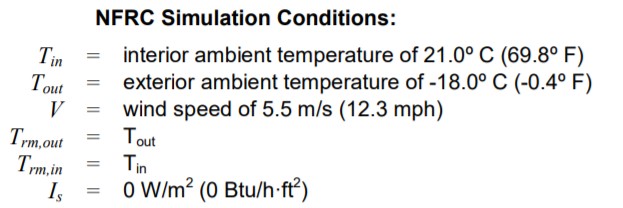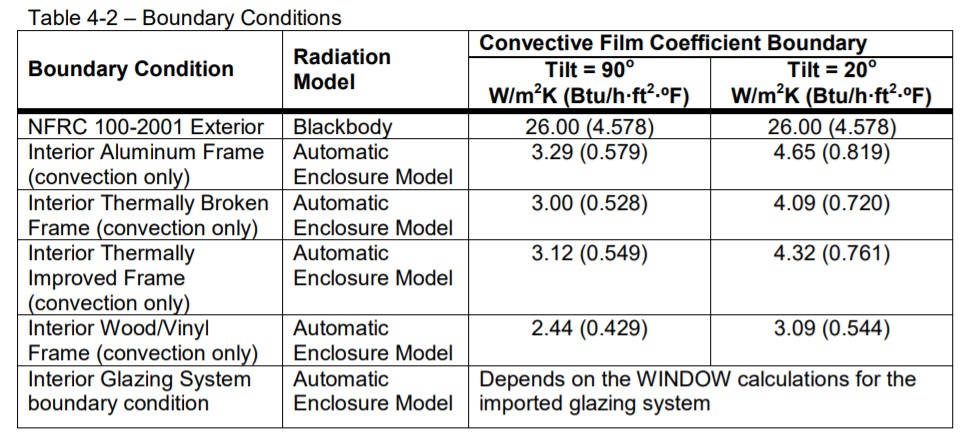First time here? Check out the Help page!
 | 1 | initial version |
The U-value in WindowMaterial:SimpleGlazingSystem includes air films, but it's just a rated value. In simulation, actual wind speed in the weather data is used And according to Engineering Reference, the wind speed is also adjusted by the building height.
Please refer to WindowMaterial:SimpleGlazingSystem section in Input Output Reference. It says the U-Factor is the rated (NFRC) value for U-factor under winter heating conditions.
According to ANSI/NFRC 100, the rated (NFRC) value for U-factor under winter heating conditions are as follows. The wind speed is 5.5m/s,resulting in the exterior convective film coefficient of 26W/m2K. (The formula used here is h=4+4V. 4+4*5.5=26W/m2K.)


If your model is located at wind speeds greater than 5.5 m/s, or if the height of your model is quite high, the actual U-factor used in energy simulation is assumed to be higher than the U-factor you entered in WindowMaterial:SimpleGlazingSystem.
Please note that Input Output Reference cautions against using WindowMaterial:SimpleGlazingSystem. "There may be significant differences in performance between the simple window system and the user more detailed model."
 | 2 | No.2 Revision |
The U-value in WindowMaterial:SimpleGlazingSystem includes air films, but it's just a rated value. In simulation, actual wind speed in the weather data is used used. And according to Engineering Reference, Reference, the wind speed is also adjusted by the building height.
Please refer to WindowMaterial:SimpleGlazingSystem section in Input Output Reference. It says the U-Factor is the rated (NFRC) value for U-factor under winter heating conditions.
According to ANSI/NFRC 100, the rated (NFRC) value for U-factor under winter heating conditions are as follows.


The wind speed is 5.5m/s,resulting , resulting in the exterior convective film coefficient of 26W/m2K.
(The formula used here is h=4+4V. 4+4*5.5=26W/m2K.)


If your model is located at wind speeds greater than 5.5 m/s, or if the height of your model is quite high, the actual U-factor used in energy simulation is assumed to be higher than the U-factor you entered in WindowMaterial:SimpleGlazingSystem.
Please note that Input Output Reference cautions against using WindowMaterial:SimpleGlazingSystem. "There may be significant differences in performance between the simple window system and the user more detailed model."
 | 3 | No.3 Revision |
The U-value in WindowMaterial:SimpleGlazingSystem includes air films, but it's just a rated value. In simulation, actual wind speed in the weather data is used. And according to Engineering Reference, the wind speed is also adjusted by the building height.
Please refer to WindowMaterial:SimpleGlazingSystem section in Input Output Reference. It says the U-Factor is the rated (NFRC) value for U-factor under winter heating conditions.
According to ANSI/NFRC 100, the rated (NFRC) value for U-factor under winter heating conditions are as follows.


The wind speed is 5.5m/s, resulting in the exterior convective film coefficient of 26W/m2K. (The formula used here is h=4+4V. 4+4*5.5=26W/m2K.)
If I think if your model is located at wind speeds greater than 5.5 m/s, or if the height of your model is quite high, the actual U-factor used in energy simulation is assumed to will be higher than the U-factor you entered in WindowMaterial:SimpleGlazingSystem.WindowMaterial:SimpleGlazingSystem.
Please note that Input Output Reference cautions against using WindowMaterial:SimpleGlazingSystem. "There may be significant differences in performance between the simple window system and the user more detailed model."
 | 4 | No.4 Revision |
The U-value in WindowMaterial:SimpleGlazingSystem includes air films, but it's just a rated value. In simulation, actual wind speed in the weather data is used. And according to Engineering Reference, the wind speed is also adjusted by the building height.
Please refer to WindowMaterial:SimpleGlazingSystem section in Input Output Reference. It says the U-Factor is the rated (NFRC) value for U-factor under winter heating conditions.
According to ANSI/NFRC 100, the rated (NFRC) value for U-factor under winter heating conditions are as follows.
follows.


The wind speed is 5.5m/s, resulting in the exterior convective film coefficient of 26W/m2K. (The formula used here is h=4+4V. 4+4*5.5=26W/m2K.)
I think if your model is located at wind speeds greater than 5.5 m/s, or if the height of your model is quite high, the actual U-factor used in energy simulation will be higher than the U-factor you entered in WindowMaterial:SimpleGlazingSystem.
Please note that Input Output Reference cautions against using WindowMaterial:SimpleGlazingSystem. "There may be significant differences in performance between the simple window system and the user more detailed model."
 | 5 | No.5 Revision |
The U-value in WindowMaterial:SimpleGlazingSystem includes air films, but it's just a rated value. In simulation, actual wind speed in the weather data is used. And according to Engineering Reference, the wind speed is also adjusted by the building height.
Please refer to WindowMaterial:SimpleGlazingSystem section in Input Output Reference. It says the U-Factor is the rated (NFRC) value for U-factor under winter heating conditions.
According to ANSI/NFRC 100, the rated (NFRC) value for U-factor under winter heating conditions are as follows.


The wind speed is 5.5m/s, resulting in the exterior convective film coefficient of 26W/m2K. (The formula used here is h=4+4V. 4+4*5.5=26W/m2K.)
I think if your model is located at wind speeds greater than 5.5 m/s, or if the height of your model is quite high, the actual U-factor used in energy simulation will can be higher than the U-factor you entered in WindowMaterial:SimpleGlazingSystem.
Please note that Input Output Reference cautions against using WindowMaterial:SimpleGlazingSystem. "There may be significant differences in performance between the simple window system and the user more detailed model."
 | 6 | No.6 Revision |
The U-value in WindowMaterial:SimpleGlazingSystem includes air films, but it's just a rated value. In simulation, actual wind speed in the weather data is used. And according to Engineering Reference, the wind speed is also adjusted by the building height.
Please refer to WindowMaterial:SimpleGlazingSystem section in Input Output Reference. It says the U-Factor is the rated (NFRC) value for U-factor under winter heating conditions.
According to ANSI/NFRC 100, the rated (NFRC) value for U-factor under winter heating conditions are as follows.


The wind speed is 5.5m/s, resulting in the exterior convective film coefficient of 26W/m2K. (The formula used here is h=4+4V. 4+4*5.5=26W/m2K.)
I think if your model is located at wind speeds greater than 5.5 m/s, or if the height of your model is quite high, the actual U-factor used in energy simulation can be higher than the U-factor you entered in WindowMaterial:SimpleGlazingSystem.. Conversely, if the wind speed is lower than 5.5 m/s, then the actual U-factor can be lower than the entered U-factor.
Please note that Input Output Reference cautions against using WindowMaterial:SimpleGlazingSystem. "There may be significant differences in performance between the simple window system and the user more detailed model."
